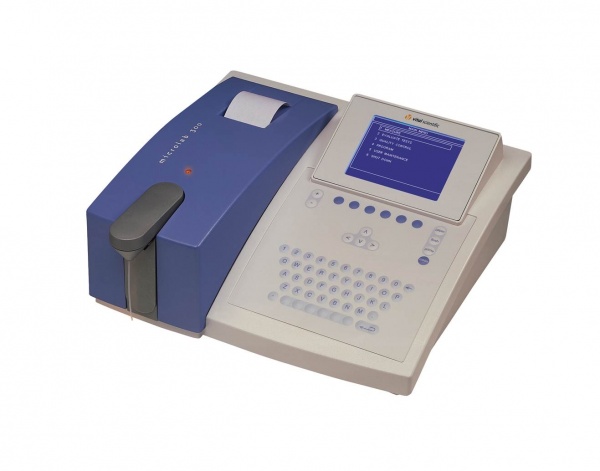
The Microlab 300 is a true semi-automated clinical chemistry analyzer in all its glory. A system that is designed as a clinical chemistry analyzer and not as a standard photometer. Thousands of users have experienced the proven reliability and high performance of the Microlab all over the world. Robust, compact and easy-to-use, it is ideal for smaller or satellite laboratory locations. Together with a superior menu of ready-to-use, liquid-stable reagents, the Microlab 300 covers primary, STAT or back-up testing needs. This system offers minimal maintenance and effective use of consumables to provide a truly cost effective operation.
Processing Center
- Optimized test environment ensures accurate results
- Measurement takes place in a specially designed patented flowcell
- Superior optical design
- Temperature controlled, 37°C
- Easy-to-train, operate and maintain
- Interactive and intuitive testing
- Built in printer
- Built in quality control
- Low maintenance required
- Cover designed for maintenance purposes
- Easy paper roll or parts replacement
- Low volumes
- Minimal water consumption
- 30 µL measuring volume
- Password protection
Operator Interface![microlab_300_soft_web[1]](https://www.elitechgroup.com/wp-content/uploads/2015/02/microlab_300_soft_web1-129x300.jpg)
- Easy-to-use
The simplicity of the software allows a skilled technician to operate the Microlab 300 within an hour. Interactive and intuitive routines lead the operator to the results quickly. The system maintenance instructions are integrated in the software. - Onboard Quality Control
QC results are stored in memory and are easily displayed on the screen. The software calculates the mean, standard deviation and coefficient of variation. - Patient Results
Retrieval of results becomes even simpler with the Microlab 300. A special evaluate patient menu gives the possibility to retrieve measured data very easily. Up to 100 patient result reports are automatically stored.
SPECIFICATION
Light Source
- Quartz-iodine lamp 12V-20W.
Wavelength Range
- Optical unit with 12 position filter wheel
- 340, 405, 505, 546, 578, 620 nm standard installed
- 6 positions for optional filters.
Photometric Range
- 0.1 to 2.3 Absorbance
- Resolution 0.001 Abs.
Detector
- Photo diode (320-1000 nm).
Blanking
- Automatic zero setting.
Operator Interface
- Membrane keyboard, for direct function and alpha-numeric entry
- Optional external keyboard
- High contrast graphical LCD display
- Real time clock, 24 hours system.
Measurement Procedures
- Kinetic measurement with linearity check
- Kinetic, with linearity check and sample slope blank
- Two point kinetic, with or without reagent blank
- End point, with or without reagent blank
- Bichromatic end point, with or without reagent blank
- End point, with sample blank and with or without reagent blank.
Multiple Testing
- Up to nine replicates
- Means, SD and CV.
Measurement Time
- Programmable, 2 to 998 seconds for kinetic and two point type of tests
- For end point fixed at 2 seconds.
Delay Time
- Programmable, 0 to 999 seconds.
Parameter Setting
- Method name
- Measurement mode
- Wavelength 1 and 2
- Aspiration volume
- Measurement delay
- Measurement time
- Factor
- Concentration standards
- Reagent blank y/n
- Sample blank y/n
- Units for results
- Levels for flagging
- Curve fit y/n
- Linearity check.
Calibration
- Factor, one-point, two-point and multi-point
- Automatic on 1 standard (linear mode)
- Automatic on up to 10 standards (non-linear mode).
Quality Control
- Two controls per test
- QC survey of last 30 control measurements
- Levey Jenning plot
- High/low flags.
Flowcell
- Metal, with quartz windows, measuring volume 30 µL.
Temperature Control
- By means of Peltier elements
- Fixed temperature at 37°C.
Aspirator System
- Internal pump of bellows type, driven by stepper motor:
- Back panel connection for waste
- Aspiration volume programmable.
Printer
- Internal matrix printer
- Normal paper
- External printer port available.
Signal Interface
- Centronics type parallel port
- RS 232 type serial port
- PS 2 type port for external keyboard.
Standards and Regulations
- CE -IVD
- CB
- UL.
Dimensions and Power Requirements
- 40 x 17 x 36,6 cm (W x H x D)
- Weight: 8,5 kg.
- 100-240 VAC nominal, 50/60 Hz
- Battery back-up to retain data

